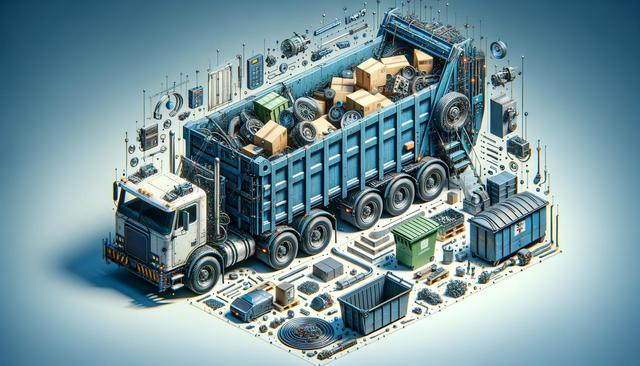Understand the Purpose and Capacity Requirements
Before choosing a dumpster trailer, it’s crucial to assess the primary purpose it will serve. Dumpster trailers are used across a range of industries such as construction, landscaping, property clean-outs, and even event management. Each of these activities may require different trailer capacities and features. Start by evaluating the type and volume of waste you typically handle. For example, heavy-duty construction debris like concrete or roofing materials will demand a trailer with a high load-bearing capacity, while yard waste or household clean-up might require less.
Dumpster trailers typically range in size from 6 to 30 cubic yards. Understanding your needs will help you avoid overpaying for unnecessary capacity or underestimating your requirements, which can lead to inefficiencies or safety concerns. Consider how frequently the trailer will be used and how it will be transported. Larger trailers may offer more value for frequent users, while smaller ones might be more manageable and cost-effective for occasional use.
Material and Build Quality
The construction of a dumpster trailer significantly impacts its durability and long-term value. High-quality steel frames and reinforcements provide better resistance to damage from heavy or sharp materials. Look for trailers built with corrosion-resistant coatings or galvanized steel, especially if the trailer will be exposed to outdoor elements regularly. Pay attention to weld quality as well—solid, continuous welds will withstand stress far better than spot welds, particularly when the trailer is fully loaded.
Additional features to look for in build quality include:
- Reinforced sidewalls and flooring
- Heavy-duty axles and suspension systems
- Weather-resistant paint or finish
- Rust-proof hardware and fittings
These design elements help ensure the trailer performs well under pressure and lasts longer, offering better value over time.
Types of Dumping Mechanisms
Another key factor to evaluate is the dumping mechanism. Different trailer models offer varying dumping systems, which can influence convenience and suitability for specific jobs. The most common types include manual, hydraulic, and electric-hydraulic dumping systems. Manual dumps are typically found on smaller trailers and are more cost-effective, but they require more physical effort. Hydraulic systems, whether powered by a battery or connected to a vehicle’s power supply, offer easier and faster unloading, making them ideal for frequent or heavy use.
When choosing a dumping mechanism, consider the following:
- Ease of use and maintenance
- Speed and efficiency of the dump process
- Compatibility with your towing vehicle
- Safety features like auto-locks or stabilizers
A more efficient dumping system can significantly reduce labor time and increase overall productivity, especially in commercial settings.
Towing and Mobility Considerations
How the trailer performs on the road is just as important as how it performs on site. Make sure to check the Gross Vehicle Weight Rating (GVWR) to ensure it aligns with your towing vehicle’s capacity. A mismatch could not only be illegal but also dangerous. Trailer features such as tandem axles, braking systems, and suspension types can affect ride stability, maneuverability, and stopping power.
Key towing features to consider include:
- Brake type (electric vs. surge brakes)
- Tire quality and load rating
- Hitch compatibility and height adjustability
- Lighting and signal systems
Having a trailer that tows smoothly and safely is essential, particularly if you’ll be driving on varied terrain or over long distances. Inadequate towing systems can lead to wear and tear on both the trailer and the towing vehicle, increasing maintenance needs and reducing operational efficiency.
Additional Features and Legal Compliance
Beyond the basic structure and function, many dumpster trailers offer optional features that can enhance usability and compliance with local regulations. For example, lockable lids can help prevent illegal dumping and protect the contents from weather exposure. Side doors or ramps can ease the loading process, particularly for heavy or awkward items. Some models also offer interchangeable bins or compartments for easier sorting of recyclable materials.
Additionally, it’s important to ensure that the trailer complies with local and federal transport regulations. This may include:
- DOT-approved lighting and reflectors
- Proper licensing and registration
- Weight restrictions and signage
Failing to meet these requirements can lead to fines or operational delays. Always consult your local Department of Transportation or waste management authority to confirm what’s needed for legal operation in your area.
Conclusion: Making a Smart Investment
Choosing a dumpster trailer involves more than just picking the right size. It requires careful evaluation of your intended use, build quality, dumping mechanisms, towing capabilities, and compliance with legal standards. Whether you’re managing a construction site or running a seasonal cleanup business, investing in a well-suited trailer can enhance efficiency, reduce costs, and ensure safer operations. By focusing on these key features and aligning them with your specific needs, you can make a more informed and valuable purchasing decision.







